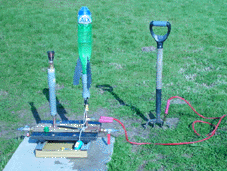

|
Cause and effect Water rockets are currently predominantly produced using plastic materials PETE bottles plastic fins etc. All these materials are relatively easy to charge with static electricity. Subsequently they fly through the air at velocities that can be anything up to 100+m/s having been pressurized by a pump with a friction seal piston and possibly a plastic cylinder.
Potential causes of electro-static charge:
launches would increase this charge unless controlled )
using batteries.
operational conditions:
inflate. The two halves of the parachute remaining stuck to each other . Or fails to release from the charged coiffe. The parachute remaining stuck to the inside of the coiffe.
correctly and can be seriously damaged. Electronic instrumentation needs to be protected from this type of environment. Precautions to be taken to avoid significant electro-static charge building up on the rocket:
multi-meter to measure the time it takes for the rocket, coiffe or launcher to discharge.
contact.
rocket.
The better the earth the shorter the discharge time. If the earth is left attached to the launcher table/tube them it can reduce the level of electrostatic charge transferred to the rocket. Examples of electrostatic electricity can be demonstrated using a balloon rapidly rubbed against the fabric of a pullover Too attract hair or stick the balloon to the wall.
Or a plastic comb rapidly rubbed against a sleeve and used to attract small pieces of plastic packaging or polystyrene. Charge build up on the screen of a television or computer discharges through you when you touch it. It also attracts lots of dust particles from the surrounding atmosphere.
To check if a parachute is significantly charged without using a electro scope. Suspend the parachute vertically from its cords and see that it is not attracted by another object. Curtains, wall etc. If it is attracted the cords will no longer hang in a vertical cone and the parachute needs to be discharged. To reduce the potential electrostatic charge capacity of the rocket avoid using plastic materials that have been either heavily rubbed or abraded during manufacture.
In industry where more and more parts are produced from plastics electro-static charge is controlled using special surface treatments like 'air plasma'.
|
This site was created on the 15th April 2003
ŠJohn Gwynn and sons2003
You're welcome to reproduce any material on this site for educational or other non commercial purposes
as long as you give us proper credit (by referring to "The Water-Rocket Explorer" http://waterocket.explorer.free.fr).